With the subject of September's upcoming Time Capsule being a little more obscure, I thought it'd be best to get their summary post up sooner then later.
 These would of course be the Anomalocaridids. A group of enigmatic arthropod that were not only one of the most alien looking creatures to have ever lived on our planet, but were one of the first to do so!
These would of course be the Anomalocaridids. A group of enigmatic arthropod that were not only one of the most alien looking creatures to have ever lived on our planet, but were one of the first to do so!
I have tracked down as many pictures of these creatures as I could, as though well known within palaeo circles, it is virtually unknown to the public.
For anyone wanting to do research on Anomalcaridids, Sam Gon's website is an excellent source of non technical (and some technical) information. Also though 20 years old now, Stephen J. Gould's book on the Burgess Shale, Wonderful Life will certainly give you an excellent introduction to why these animals have had a big impact on palaeontological studies in the last 3 decades.
All the pieces included here are the most popular and accuarte depictions of Anomalocaridids currently on the web. I have tried to track down the artists of these pieces as best I could, however in many cases I could not find them. This is a sad case when websites use other peoples' work to enhance their own site without proper acknowledgement. A stance we here at ART Evolved do not endorese. Though we have used this art (without permission) we are attempting to remedy this lack of credit by tracking down all the "unknown artists" who have found the their work posted on the web.
If you know any of the "Unknown" creators of the pieces below please let me know. It is important that all art used on the internet be credited to its proper creator. If your work appears on this website, and you wish us to take it down, we will do so immediately. Email us at artevolved@gmail.com .
We at ART Evolved are working on collecting and documenting all these piece's creators for a definative virtual record! Please help us...
Before "Fame"
 The Burgess Shale by Charles Knight.
The Burgess Shale by Charles Knight.
This is the first popular reconstruction of the Burgess Shale environment by none other then Palaeo-Art legend Charles Knight. This painting and the ideas it manifests are a central argument in Gould's book Wonderful Life, and I can't recommend reading it enough (especially this month!).
Interestingly despite the fact that no Anomalocaris is clearly visible there are arguably 3 of them in there. Up until the 1970's Anomalocaris was not recognized as the large mega predator it is today. Various disarticulated bits and pieces of it had been found and misidentified as other types of animals. In this picture you see its arm reconstructed as the strange purple shrimp in the upper left hand corner and its mouth as 2 jellyfish in the top right.
The First Iconic Image
 This is the first correct popular rendition of an Anomalocaridid to circulate. As it was the first such picture of the entire bizarre creature together, it has been very influential on many of the reconstructions that were to follow.
This is the first correct popular rendition of an Anomalocaridid to circulate. As it was the first such picture of the entire bizarre creature together, it has been very influential on many of the reconstructions that were to follow.
Drawn by Marianne Collins for Gould's Wonderful Life, the only major flaw with it is despite being labelled as an Anomalocaris, this is a different genus of Anomalocaridid called Laggania. It was an innocent enough mistake at the time, and neither Collins or Gould should be held accountable for it. Laggania was only recognized as a seperate animal many years after Gould's book.
However sadly this mistake has been carried on in recreations ever since (especially on the internet) mistakenly labelling Laggania as Anomalocaris. A simple correction in current reprints of Gould's book would do wonders to fix this. That and our gallery could be a first step to trying to spread the word on this mix up.
Laggania
A very rare Anomalocaridid from the Burgess Shale, British Columbia Canada. Only one or two specimens have been thus far been discovered.
It is quite unique among Anomalocaridids due to its triangular head shape and lack of tail fans.
Also compared to others in the group Laggania had very short arm tentacles lined with very long bristle like spines. These are thought to have been used for passive filtration feeding on very tiny creatures, as opposed to traditional active predator of larger prey normally associated with Anomalocaridids. Supporting the more passive feeding strategy Laggania's eyes are set much further back on the head then other Anomalocarids. It has been compared to the baleen whale of the Cambrian.
 A close up on Laggania from the famous Burgess Shale reconstruction in Time Magazine by John Sibbick. Based heavily on the era of Gould's popularization of the Shale, this Laggania is incorrectly labelled Anomalocaris, and here depictacted being an active predator. Which is most likely incorrect, but again forgivable at the time of the pieces creation as it was thought to simply be a variant of Anomalocaris.
A close up on Laggania from the famous Burgess Shale reconstruction in Time Magazine by John Sibbick. Based heavily on the era of Gould's popularization of the Shale, this Laggania is incorrectly labelled Anomalocaris, and here depictacted being an active predator. Which is most likely incorrect, but again forgivable at the time of the pieces creation as it was thought to simply be a variant of Anomalocaris.

Lagginia by Karren Carr
 Laggania by an Unknown Artist, but this is unacceptable. They deserve credit for this great piece of work. If you know the artist behind this piece please email us at artevolved@gmail.com
Laggania by an Unknown Artist, but this is unacceptable. They deserve credit for this great piece of work. If you know the artist behind this piece please email us at artevolved@gmail.com
 Underside of Laggania by Sam Gon
Underside of Laggania by Sam Gon

Side Profile of Laggania by Sam Gon

A comparison of the head structures and anatomy of Laggania (on the left) to Anomalocaris (on the right) by Marianne Collins
Anomalocaris
The most iconic and famous of the Anomalocaridids. Found not only in Canada at the Burgess Shale but also in China, America, and Australia. Making it the most widespread and common of Anomalocaridids so far found.
Different species occur in these different regions. The most pronounced differences between those so far described being the Chinese Anomalocaris saron having 2 pronounced thread like tail fins where the Canadian species Anomalocaris canadensis did not.
 Anomalocaris canadensis
Anomalocaris canadensis by
Yukio Sato. Cover of Simon Conway Morris' book
The Crucible of Creation, his counter to Gould's book
Wonderful Life. Though I personal disagree with Morris' ideas, his cover art is second to none.
 Anomalocaris canadensis
Anomalocaris canadensis by an
Unknown Artist, but this is unacceptable. They deserve credit for this great piece of work. If you know the artist behind this piece please email us at artevolved@gmail.com
 Anomalocaris canadensis
Anomalocaris canadensis by
Sam Gon .
 Anomalocaris canadensis
Anomalocaris canadensis by an
Unknown Artist, but this is unacceptable. They deserve credit for this great piece of work. If you know the artist behind this piece please email us at artevolved@gmail.com  Anomalocaris canadensis
Anomalocaris canadensis by
Nuko  Anomalocaris canadensis
Anomalocaris canadensis by an
Unknown Artist, but this is unacceptable. They deserve credit for this great piece of work. If you know the artist behind this piece please email us at artevolved@gmail.com  Anomalocaris canadensis
Anomalocaris canadensis by an
Unknown Artist, but this is unacceptable. They deserve credit for this great piece of work. If you know the artist behind this piece please email us at artevolved@gmail.com Anomalocaris canadensis
Anomalocaris canadensis by
Sam Gon .

An Anomalocaris canadensis menaces the Burgess Shale by uncredited artist at http://www.naturalhistoryexplorer.com/ . They deserve credit for this great piece of work. If you know the artist behind this piece please email us at artevolved@gmail.com
 Burgess Shale ecosystem by an Unknown Artist, but this is unacceptable. They deserve credit for this great piece of work. If you know the artist behind this piece please email us at artevolved@gmail.com
Burgess Shale ecosystem by an Unknown Artist, but this is unacceptable. They deserve credit for this great piece of work. If you know the artist behind this piece please email us at artevolved@gmail.com
With an Anomalocaris canadensis about to menace its small contemporaries.
You'll also note how the far Anomalocaris is depicted here having proper body segments, where the majority of the other restorations in this post lack these. This is an interesting topic, and one I plan on touching upon in another post soon.
This image of the Anomalocaris overshadowing the rest of life in the Cambrian was so strong it was recreated in Anomalocaris' only Television appearance...
 Anomalocaris saron by Impossible Pictures from Walking with Prehistoric Monsters.
Anomalocaris saron by Impossible Pictures from Walking with Prehistoric Monsters.
 Anomalocaris saron by uncredited artist at http://www.naturalhistoryexplorer.com/. Unknown Artist, but this is unacceptable. They deserve credit for this great piece of work. If you know the artist behind this piece please email us at artevolved@gmail.com
Anomalocaris saron by uncredited artist at http://www.naturalhistoryexplorer.com/. Unknown Artist, but this is unacceptable. They deserve credit for this great piece of work. If you know the artist behind this piece please email us at artevolved@gmail.com
Note the Chinese species tail fins in the following pictures versus the lacking Canadian species in the previous pictures.
 Anomalocaris saron
Anomalocaris saron by
Craig Dylke, which is yes me. I do not include my own piece out of ego, but due to the fact it (
or an alternate version) appear within the first 1-5 pages of google image
searches using the terms "
Anomalocaris", "Burgess Shale
Anomalocaris", or "
Anomalocaris Burgess Shale".
 Anomalocaris saron by Impossible Pictures
Anomalocaris saron by Impossible Pictures
 Anomalocaris saron by Impossible Pictures
Anomalocaris saron by Impossible Pictures
 Anomalocaris saron
Anomalocaris saron by
Sam Gon .
Hurdia
The most recently described (but not technically discovered)
Anomalocaridid. Though first recognized from a complete specimen from the Burgess Shale, incomplete specimens of this genus are known from the United States, China, and Europe.
The most remarkable and unique feature of this genus is the giant spiked hollow shell on the front of the head. Otherwise the head
configuration behind this shell was very similar to
Anomalocaris, though
Hurdia's tentacles were slightly reduced, and it is believed this genus was a scavenger or hunted weaker prey then Anomalocaris.
 Hurdia
Hurdia by
Marianne CollinsAmplectobelua
A rather small
Anomalocaridid, compared to its relatives, but was still quite large for a Cambrian animal.
Amplectobelua is so far only known from the
Maotianshan Shale (often referred to incorrectly as the
Chengjiang Shale) of China.
Amplectobelua is for all intents and purposes a compact version of
Anomalocaris saron, most notable for
restorations sake smaller arms and body.
 Amplectobelua
Amplectobelua by uncredited artist at
http://www.naturalhistoryexplorer.com/.
Unknown Artist, but this is unacceptable. They deserve credit for this great piece of work. If you know the artist behind this piece please email us at artevolved@gmail.com Amplectobelua
Amplectobelua by
Sam Gon  Amplectobelua
Amplectobelua by
Sam Gon  Amplectobelua
Amplectobelua by
Sam Gon Parapeytoia
One of the strangest
Anomalocaridids by far, if it was a true
Anomalocaridid. Animals such as
Parapeytoia and
Kerygmachela (the next animal included in this post) challenge the
defination of the
Anomalocaridids (which has not been updated since the recognition of
Anomalocaris in 1985) and require workers in the field to come up with a more precise and definable criteria for the group.
Calling into question just how closely related
Parapeytoia was to the Anomalocaridids, was the fact it had legs underneath the traditional Anomalocaridid fin lobes. Additionally its feeding tentacles branched off into 4 spikes (very similar to the strange yet-not Anomalocarid arthopod
Yohoia).
 Parapeytoia
Parapeytoia by
Sam Gon  Parapeytoia
Parapeytoia by
Sam Gon  Parapeytoia
Parapeytoia by
Sam Gon  Parapeytoia
Parapeytoia by an
Unknown Artist, but this is unacceptable. They deserve credit for this great piece of work. If you know the artist behind this piece please email us at artevolved@gmail.com
Kerygmachela
Another uncertain relative of the Anomalocaridids. Despite being blind, having much finer tentacles arms, and its ring like mouth in the front of the face as opposed to below it
Kerygmachela shares a huge number of anatomical similarities to the Anomalocaridids. It is from the unique Cambrian era Sirius Passet Lagerstätte of Greenland.
 Kerygmachela
Kerygmachela by
Sam Gon 
Kerygmachela by
Sam Gon Schinderhannes
A HUGE discovery this year (which is saying something considering some of the fossils described in 2009), Schinderhannes was an Anomalocaridid from the Devonian! Up until this genus the group had only been known from the Cambrian. This extended their reign for an impressive 100 million years. It has seriously challenged the Anomalocaridid's place in the Arthropod family tree and calls into question the theory Stephen J. Gould presents Anomalocaris as the linch-pin for in Wonderful Life (but again it is very much worth the read!).
For an Anomalocaridid Schinderhannes had very large eyes, small feeding tentacles, and a pair of strange ridgid fins behind the head. Additionally its fin lobes were underneath the body as opposed to sticking out the sides.

The pictures that accompanied the formal paper, with a restoration by an
Unknown Artist, but this is unacceptable. They deserve credit for this great piece of work. If you know the artist behind this piece please email us at artevolved@gmail.com
Random Pictures
Not all the pictures I encountered were of, shall we say, scientific quality, but I thought warranted some attention. Afterall here at ART Evolved we're not
just about scientific accuracy.

Interesting head configuration Anomalocarid by an
Unknown Artist, but this is unacceptable. They deserve credit for this great piece of work. If you know the artist behind this piece please email us at artevolved@gmail.com

Anomalocaris by
Ray Troll
Fossils
Lastly for those of you who like to reference the remains of the animals themselves here are some snap shots of various specimens I stole off
Sam Gon's website.
 Anomalocaris canadensis.
Anomalocaris canadensis.Pay attention to this specimen's "neck" closely. I'll be doing a post on how this fossil seems to counter nearly every restoration of Anomalocaris seen in this post.
 Anomalocaris canadensis
Anomalocaris canadensis Anomalocaris canadensis
Anomalocaris canadensis
 Anomalocaris canadensis
Anomalocaris canadensis








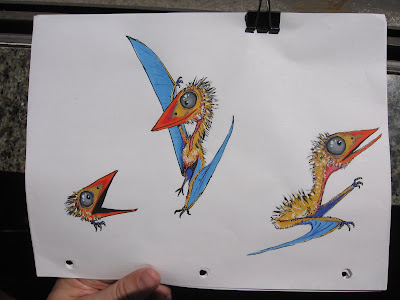





 Here is the finished piece, for reference.
Here is the finished piece, for reference.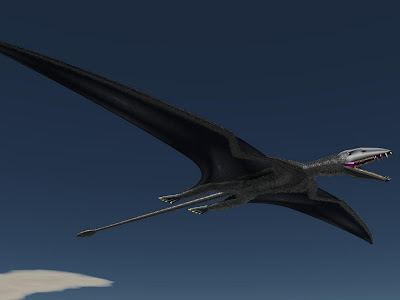 They didn't start this way!
They didn't start this way!
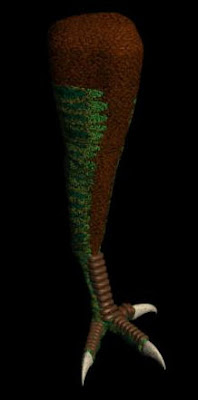

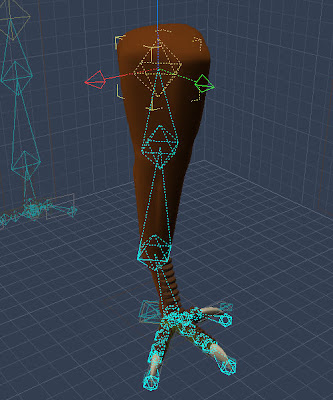 That is of course skeletal rigging. What it does is allow you to define specific points within a 3D object that now act as points of articulation and rotation. In short it creates a real joint.
That is of course skeletal rigging. What it does is allow you to define specific points within a 3D object that now act as points of articulation and rotation. In short it creates a real joint. 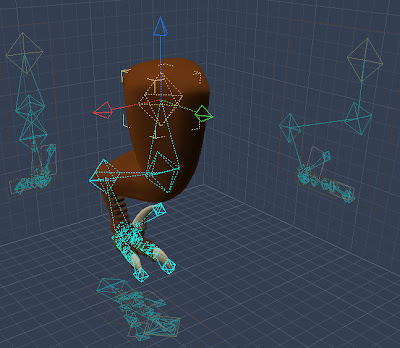 Once applied to a model you simply have to grab one of the diamonds and you can instantly and
Once applied to a model you simply have to grab one of the diamonds and you can instantly and 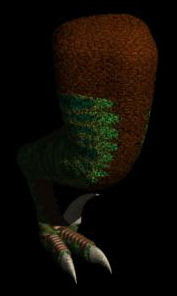 After rigging and posing we get something much more life like!
After rigging and posing we get something much more life like!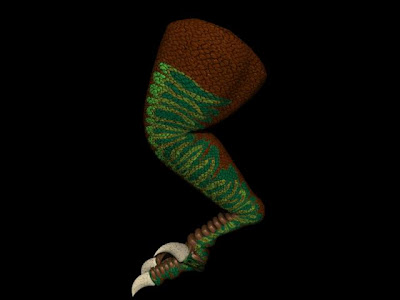 Skeletal rigs take care of all the problems I mentioned before.
Skeletal rigs take care of all the problems I mentioned before.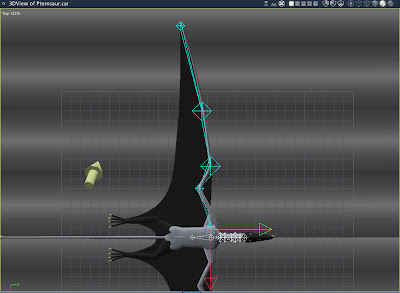
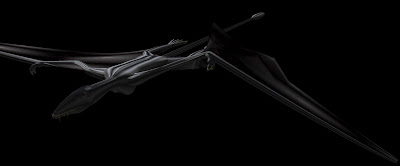 Not defining any "bones" in the membrane meant the computer could just bend and stretch it
Not defining any "bones" in the membrane meant the computer could just bend and stretch it 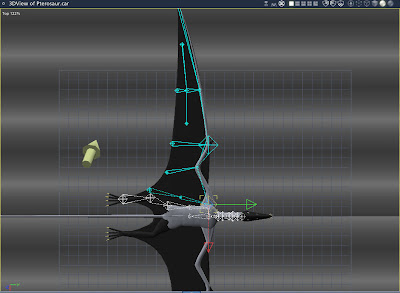 I had my fears that this was going to get complicated (I hate it when I'm right, but we'll get to that in a bit). Just so I would knew, I tried a minimal fix to the problem.
I had my fears that this was going to get complicated (I hate it when I'm right, but we'll get to that in a bit). Just so I would knew, I tried a minimal fix to the problem.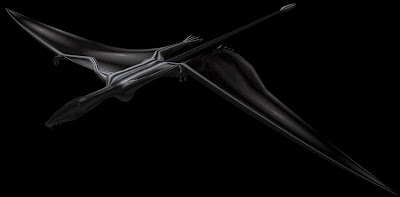 I was half right it turns out. Yes the wing bent perfectly at the
I was half right it turns out. Yes the wing bent perfectly at the 

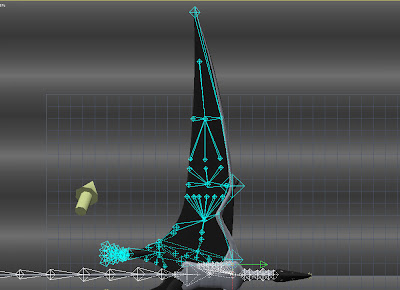 So once again I had to go in and add a dozen branching off membrane "bones" to help define and control the distortion along the legs.
So once again I had to go in and add a dozen branching off membrane "bones" to help define and control the distortion along the legs. In the end I had a pretty good "simple" rig that allowed me pretty good fluid control on my
In the end I had a pretty good "simple" rig that allowed me pretty good fluid control on my  These would of course be the
These would of course be the  The Burgess Shale by Charles Knight.
The Burgess Shale by Charles Knight.  This is the first correct popular rendition of an
This is the first correct popular rendition of an  A close up on
A close up on 

 Underside of
Underside of 










 Burgess Shale ecosystem by an Unknown Artist, but this is unacceptable. They deserve credit for this great piece of work. If you know the artist behind this piece please email us at
Burgess Shale ecosystem by an Unknown Artist, but this is unacceptable. They deserve credit for this great piece of work. If you know the artist behind this piece please email us at 















 Kerygmachela by
Kerygmachela by  The pictures that accompanied the formal paper, with a restoration by an Unknown Artist, but this is unacceptable. They deserve credit for this great piece of work. If you know the artist behind this piece please email us at
The pictures that accompanied the formal paper, with a restoration by an Unknown Artist, but this is unacceptable. They deserve credit for this great piece of work. If you know the artist behind this piece please email us at  Interesting head configuration Anomalocarid by an Unknown Artist, but this is unacceptable. They deserve credit for this great piece of work. If you know the artist behind this piece please email us at
Interesting head configuration Anomalocarid by an Unknown Artist, but this is unacceptable. They deserve credit for this great piece of work. If you know the artist behind this piece please email us at  Anomalocaris by
Anomalocaris by 
 Anomalocaris canadensis
Anomalocaris canadensis
 Anomalocaris canadensis
Anomalocaris canadensis